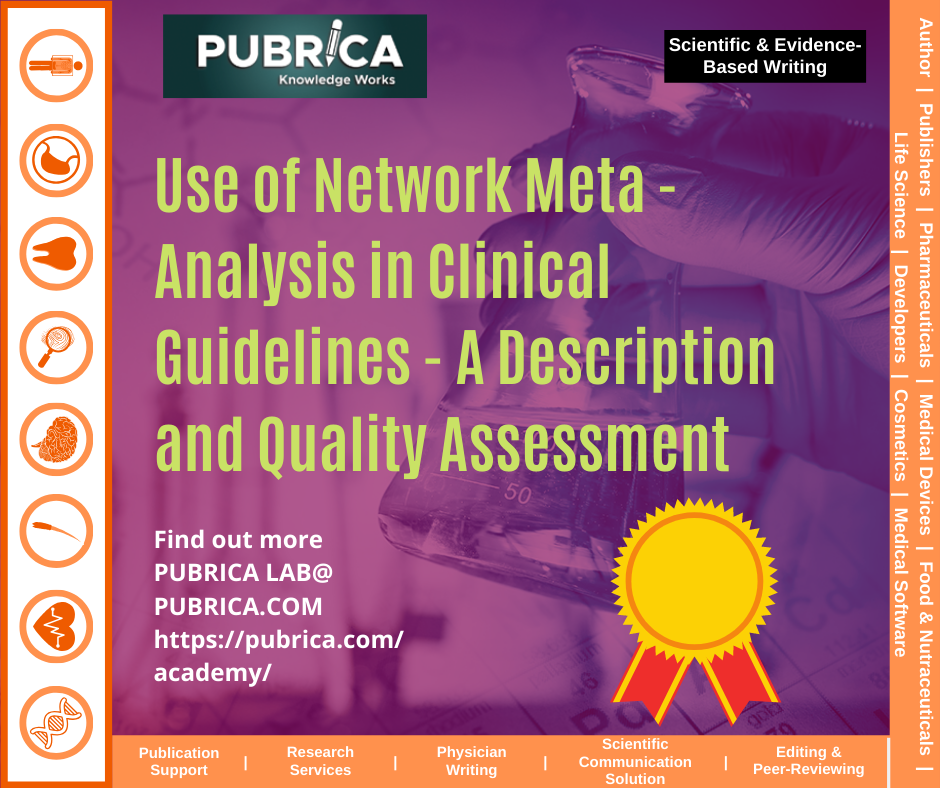
Use of Network Meta-analysis in Clinical Guidelines: A Description and Quality Assessment
November 22, 2019
Are Languages Still A Major Barrier To Global Science
December 25, 2019When we make a clinical decision it requires balanced decision among resources, tasks, skills and values. It relies on external aspects that are not easily modulated (such as religious beliefs or economic resources) and largely beyond the reach of most researchers.
Meta-analysis service plays an important role in clinical decision making. The meta-analysis involves in pair meta-analysis (goes from a 2-D to a multidimensional analytical framework) and network meta-analysis (several processes are being generated, like the adjusted indirect comparison, mixed-treatment comparison, multi-treatment meta-analysis, multi-arm meta-analysis and multivariable meta-analysis).
The key features of network meta-analysis must be as evidence-based (From pairwise meta-analysis to network meta-analysis) and reviewing process also should be designed (before the data are effectively retrieved) and registered (the evaluation protocol should be published immediately after finalizing an out-and-out repository site) as per the guidelines at hand for plan, carry out, and reporting of a network meta-analysis.
Some factors are also important for the network meta-analysis as:
Search: There are several available databases such as MEDLINE/PubMed, Cochrane Library, Europe PubMed Central, SciELO, LILACS, Embase, etc. must be used for the searching process to lead the appropriate evidence.
Selection: The selection of the study being an important step towards the network meta-analysis.
Choosing the framework: Among all frameworks Bayesian framework is considered to be most popular and accepted framework for NMA. It allows more robust modeling that can easily adjustable for simpler evidence networks.
Choosing the statistical package: There are several statistical packages available. The WinBUGS tool is one of the most commonly used packages. It is quite easy to command and can be used with ease by R and other packages for the Bayesian modeling and analysis.
Choosing the suitable statistics: Binomial model generates relative risks, risk differences, odds ratios, probabilities of being best, numbers needed to treat, rankograms, and the surface under the cumulative ranking curves.
A network meta-analysis done with little studies cannot be considered very convincing, and its findings should possibly be ignored or used to create hypotheses at best. Numerous methods have been suggested for evaluating small-research results, including funnel plots inspection after rectifying summary estimates of the subgroup, the Copas method and regression testing.
Future perceptions of the network meta-analysis are:
Coverting synthesis of evidence to action:
All the findings of a network meta-analysis should be applied to direct decision making, determine how to best interpret the assessment results and apply them in clinical practice, and to incorporate the intervention thoroughly in depth with the most desirable risk-benefit balance. The best possible way to do this is by absolute risk measurements, numbers required to be treated, and rankograms, making decision on credible or confidence intervals, instead of point estimates, while identifying the parallel effect of a specific intervention on different endpoints. Therefore, when multiple interventions hold an analogous beneficial risk-benefit profile, it is important to choose the one which is easier or cost effective to execute.
Toward accessibility and integration:
The future of network meta-analysis lies in the thorny process of steering between the Scylla of state-of-the-art processes of performing an acceptable systematic review and the Charybdis of effective dissemination and thriving accomplishment by stakeholders and decision-makers. Clear and easy tools catering innovative solutions to the complex issues have been dominating the clinical practice and Research in the last few decades. A brilliant resource for clinical research processes is Kaplan-Meier method backed survival analysis with its concise, perfect, and robust findings in daily research, in spite of its application in a massive amount of diversified and occasionally tricky contexts.
In near future, network meta-analysis and synthesis evidence will be a reality by the related application of straightforward but vigorous packages to implement network meta-analysis on numerous platforms like smartphones and tablets. Moreover, it is also a probability to create intelligent trial databases which will automatically upload the data received from individual data in a sort of collective network meta-analysis. No single meta-analysis should be viewed as the final, but rather as a tool that makes a refined form of evidence available to lead more accurate clinical practice.
Network meta-analysis is a unique and powerful tool for enhancing clinical decision making. When converting to action, knowledge that rapid systematic reviewing processes yield could be advantageous. The preliminary assessment results suggest that gold standard NMAs might be replaced by a modified rapid NMA approach. Evaluation of judgment could be used to compare summery methods of proof.
Network meta-analysis with modest improvements might replace gold standard network meta-analysis. The researchers with execution tools might use a more advanced network meta-analysis technique to lower the time and resources required for knowledge transfer to practice while creating more patient-based tools.
Limitations:
Only specific situations require the network meta-analysis and inappropriate use of network meta-analysis can lead to misleading results as limited network connectivity (Most of the available researches have un-compared all available treatments due to time or financial restraints; limited interpretation of indirect evidence; limited interpretation of ranking analysis; and limited experience of clinicians with the statistics of network meta-analysis (due to study conduction by Un-trained clinicians and statistician).
Tags:
Scientific Research services | Meta Analysis Evaluation | Network Meta Analysis | Meta analysis research | Medical Writing Services
